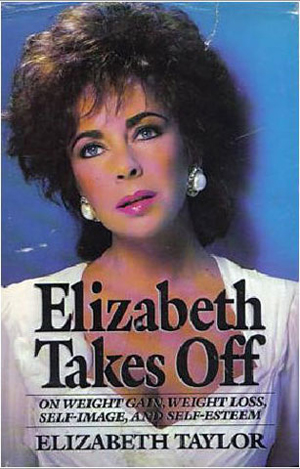Elizabeth Taylor, one of Hollywood’s most glamorous actresses, has many credits to her name. Over the course of her lifetime, she won three Oscars, two Golden Globe Awards, and Lifetime Achievement Awards from both the Screen Actors Guild and American Film Institute. Her well-publicized personal life included a whopping eight marriages (two to the same person), a vast $150 million jewelry collection, and championing charity causes such as AIDS research. What’s lesser known, or remembered, is the diet book she wrote in 1988 entitled Elizabeth Takes Off: On Weight Gain, Weight Loss, Self-Image, and Self-Esteem.
Taylor’s diet book, brought back to the limelight by NY Mag, is a mishmash of diet tips, recipes, and a personal memoir. She told interviewers at the time that she wanted to write it because she was used to extremes, black and white, and that then she wanted to cultivate the gray in her life. At mid-life, she wanted stability, and to pass this thinking on to others.
A good practice, for sure, but her diet food choices? Not so much. Many of Taylor’s food choices in the book are questionable. She eats things like cottage-cheese-sour-cream dip over fruit for breakfast and steak and peanut butter sandwiches for lunch. Dry toast, minted new potatoes, fillet of sole, and swordfish with lime are some other foods in the book. She advocates eating a lot of fish and not a lot of red meat or bread. Her diet also stresses eating fresh fruits and vegetables regularly.
One intriguing facet of the Liz Taylor diet is that she advised one “controlled pig out” day every week to help her stick to her diet. Many diets encourage something like this, in which they say moderation is key, but the fact that she comes right out and calls it a pig out session is hilarious. For this, Taylor ate things she loved, like fried chicken and mashed potatoes, gravy, lima beans, corn, and chocolate cake or sundaes.
For exercise, Taylor recommends some aerobic exercise, but not a great quantity. During this time of her life she would swim and do mild toning exercises for her physical activity. Her diet stresses getting down to a manageable weight and staying there, not gaining muscle or doing a lot of cardio workouts.
What may be more helpful than her diet and exercise choices is what Taylor wrote about the psychology of dieting. She talks about how eating became a replacement for what was lacking in her life, how when she went to a treatment center for alcoholism her diet was ignored, and what it was like when her third husband died and she had to keep control of her life.
“You have to get your head at the right place,” she said in an interview with a New York Times reporter in 1986. “Where you can make it click. Without that inner click it doesn’t matter how many fad diets you go on.”
Elizabeth Takes Off is a priceless read for those interested in the legendary icon. What we know today about dieting and health makes some things in the book outdated, but if nothing else, her inclusion of the mental health side of weight loss and food relationships is still relevant.
Also Read:
Top 15 Most Popular Celebrity Diets
Kirstie Alley Sued Over Claims of Losing Weight with Organic Liaison
Jordin Sparks’ Bikini Body Credited to Zumba and a 50 Pound Weight Loss
